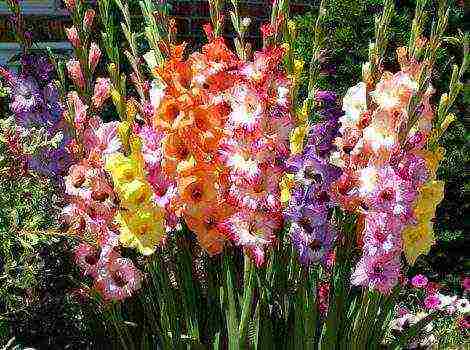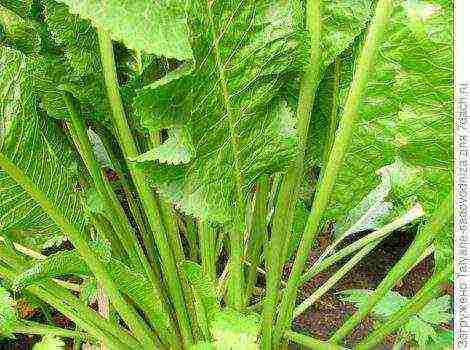Content [show]
Buying seedlings is a kind of lottery, because even a specialist will not always determine its potential by the appearance of a one-year-old plant. To increase your chances of success, you need to follow some simple rules, which we will talk about.
Cherries and cherries are usually chosen by those with a sweet tooth who adore the taste of juices, preserves, and jams made from these aromatic berries. But in order for everything to work out as dreamed of, the purchase of seedlings must be taken very seriously.
Where is the best place to buy seedlings?
It is definitely not worth doing this on the market or from the hands - instead of a cultivated variety, you can slip a wild seedling, a stock or an old small-fruited variety of Vladimirskaya cherry. Better drive up to a specialized nursery, which is not engaged in the resale of seedlings, but in their cultivation and sale. Such kennels for the most part value their reputation and it is simply not profitable for them to deceive you.
But even in a nursery with a good reputation, it is sometimes possible to purchase low-quality planting material, which, through an oversight or negligence of the staff, ended up on the shelf. To prevent this from happening, you need to understand some of the intricacies, to know the characteristics that distinguish a healthy, high-quality cherry or sweet cherry seedling from an off-grade one.
Choosing the time to buy a seedling
It is generally known that stone fruit crops are preferable to plant in spring. But with the purchase of cherry and sweet cherry seedlings, it is not worth delaying until spring. The thing is that in the autumn, the choice of planting material is much greater, and the variety of varieties is richer. And in the spring, as a rule, shops sell leftovers, and there is no certainty that the seedlings were stored correctly, and not somehow, that their root system and aboveground part were not dried.
However, if you have nowhere to store seedlings all winter, buy them in the spring - this can also find its advantages. At this time, prices for planting material are usually lower.Only you need to choose a plant more carefully and meticulously.
Step-by-step inspection of the seedling: what to look for
So, you came to the nursery, and this is the picture in front of you: in the price list there is a long list of varieties, and in large boxes filled with sawdust, a string of cherry and sweet cherry seedlings. A beginner gardener can very easily get confused, choose the first seedling that comes across and hastily go home. You cannot do this, because you are acquiring a plant that will settle on your site for many years.
You should not miss tall, giant seedlings with a large number of shoots, because such plants take root badly, their root system is powerful, and it is difficult to dig up a tree for sale without damaging it. Better to pay attention to annual cherry and sweet cherry seedlings... This is also more profitable (such seedlings are cheaper), besides, they take root much better.
In order not to buy a wild game or a low-quality plant, it is advisable to buy seedlings in the nursery.
The first thing to look for when examining a seedling is to find place of budding... Usually it is located at a height of 5-15 cm from the root collar. At this point, the stem is slightly curved, growing slightly to the side. If this sign is not present, then there is a high probability that you have a seedling in front of you, and not a full-fledged varietal seedling. Most likely, it will not have the characteristics that the declared variety should have.
If you find the site of vaccination, continue further examination. Annual cherry seedlings are usually 85-95 cm high, and two-year-olds, as a rule, are higher - up to 2 m. The only exception is the Bystrinka cherry variety. Even an annual plant of this variety can reach a height of 1.5 meters.
Then you need to examine the shoots. So, for a standard annual cherry at least 8 shoots, 10 to 20 cm long. In a biennial plant, these shoots are already about 20-25 centimeters, they have branches, and their total number is not less than 12.
As for the root system, it is approximately the same in volume for both the two-year-old and the one-year-old. It differs only in length. So, in one-year-olds, the length of the roots is about 25 cm, older seedlings have 10-12 cm more. Truth, this rule only applies to cherries. Indeed, the root system of a sweet cherry is very powerful, and it is quite difficult to dig out a two-year-old seedling. Therefore, the vast majority of nurseries sell only annual cherry seedlings. Only a very small number of plants are left for the so-called rearing.
So, the height of an annual cherry seedling, as a rule, is about 1.5 meters, it has a well-developed lobe of roots and 2-4 branching shoots.
Sometimes it happens that a cherry seedling has no branches at all. This is fine, if the thickness of the stem is at least 2-2.5 cm (whereas the thickness of the sapling with branches is 1.8-2 cm). So you should not be afraid to buy an unbranched seedling. Just after planting, you need to book it, that is, cut off the top of the head 19-22 cm above the kidney.
Determining the "health" of the seedling
When choosing a seedling, pay attention to condition of roots and aerial parts... The roots should be moist, without growths, the aboveground part should also be free from growths, damage and broken shoots.
In order to check whether the roots and shoots are overdried, it is necessary to bend a small root into a ring. It should roll up without crunching and be “alive” to the touch - wet, whitish-green in color. Examine the shoots, too, try to bend them - the live ones bend well and do not crunch, and the bark at the fold gathers into an "accordion", but does not exfoliate.
If the shoots crack even with a slight bend, and the bark on them flakes off in shreds, then, most likely, they are overdried. Such planting material is not worth buying.
And, of course, pay attention to presence of leaves: according to GOST, there should be no leaves on the seedling for planting cherry and sweet cherry - keep this in mind.
Questions to ask the seller
When buying a cherry or sweet cherry seedling, be sure to ask the seller the following important points:
- characteristics of the variety;
- flowering period of the plant;
- ripening dates of fruits;
- the most suitable for the plant of the variety you need according to the flowering period are pollinator varieties, without which neither cherry nor sweet cherry will bear fruit.
How to prepare seedlings for transportation
In order to keep the seedlings intact and not spoil their presentation, they also need to be transported correctly. It will help to keep the roots from drying out. talkera (a mixture of clay and soil in equal parts, diluted with water), in which they should be dipped, and then dipped in sawdust. The sawdust will stick to the chatterbox and play the role of a mulch layer - retain moisture. After that, the roots need to be well packed - wrapped in burlap or placed in a tight garbage bag.
It is important to transport and store seedlings correctly until the moment of planting.
How to preserve seedlings before planting
Since almost all cherry and sweet cherry seedlings are purchased in the fall and planted in the spring, it is important to store them correctly before planting. So that the seedlings do not suffer from the cold and from rodents, a dig is made.
To do this, you need to dig a small groove with a depth of 45-55 cm. It should be located east to west. From the south, the wall of the fossa must be made inclined (the optimal angle is 45-50 °), and from the north - vertical. The seedlings should be placed in the groove with their crowns above the ground and facing south. This will protect the sensitive plant bark from sunburn during winter and spring.
Then it must be very good sprinkle the roots of seedlings with moist soil, tighten it up. So that there are no voids left between the roots, which can lead to their freezing, the soil after dusting must be watered again.
Along the boundaries of the digging you need sketch spruce branches and decompose the poisoned bait to keep the seedlings from rodents. If possible, in winter you can visit the dig site to throw more snow on the roots.
Choosing a good, strong planting material is not easy, but very important. How scrupulous you will be when choosing cherry or sweet cherry seedlings depends on how soon your stone fruits begin to bloom and bear fruit, whether they will pamper you with a generous harvest or cause only a grin of disappointment. We hope our review will help you avoid many mistakes. Good and sweet harvests to you!
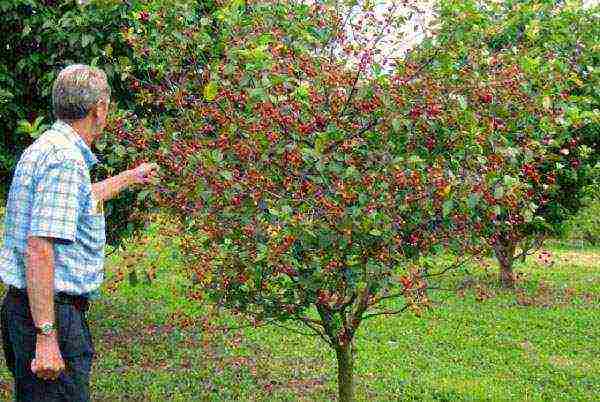 Cherries grow in almost every garden, even if there is no garden - at least one or two trees are always present near the house or even in the middle of the flower bed. The northern regions of our country are no exception, however, not everyone succeeds in choosing the best cherry variety for the Moscow region. First of all, this is due to the special climatic conditions of the Moscow region, because often frosts in this region reach 35 degrees.
Cherries grow in almost every garden, even if there is no garden - at least one or two trees are always present near the house or even in the middle of the flower bed. The northern regions of our country are no exception, however, not everyone succeeds in choosing the best cherry variety for the Moscow region. First of all, this is due to the special climatic conditions of the Moscow region, because often frosts in this region reach 35 degrees.
Before figuring out what characteristics cherry varieties should have for growing in the northern regions, and which cherry will successfully take root here, it is worth talking a little about the climate of the Moscow region.
Harsh winters of the Moscow region
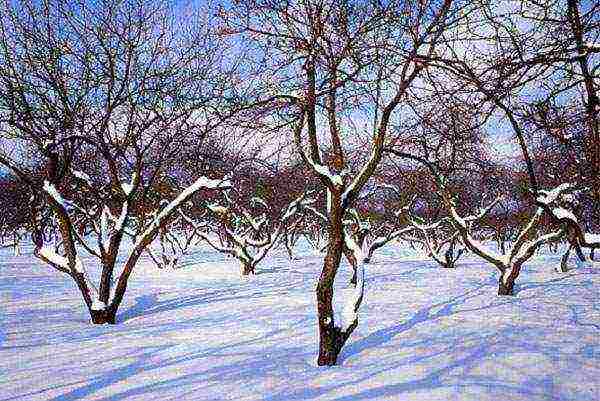 As noted above, winters in the Moscow region are quite harsh, in addition, such disasters as icing often occur. Therefore, cherry varieties for the Moscow region should have:
As noted above, winters in the Moscow region are quite harsh, in addition, such disasters as icing often occur. Therefore, cherry varieties for the Moscow region should have:
- good frost resistance - to withstand such a low temperature regime;
- winter hardiness - to endure sharp frosts or icing.
The most common diseases of fruit trees
Fruit trees growing on the territory of the region are very often susceptible to diseases, among which the palm was given to:
- Coccomycosis. It affects the deciduous part - the leaves gradually change color, turn yellow and crumble.

- Moniliosis. It affects the fruits - the cherries are covered with a white bloom and rot.
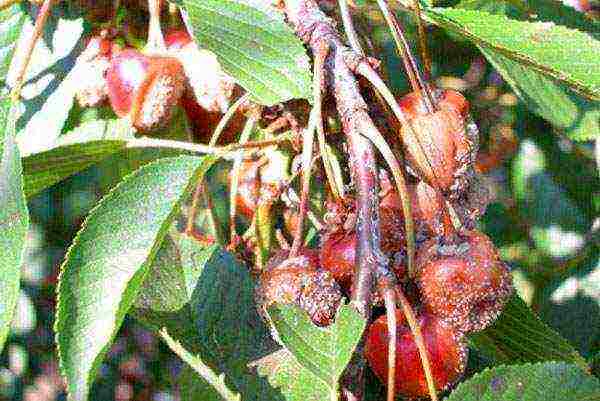
That is why cherries for the Moscow region must also have increased resistance to these diseases, since cherries can be eliminated only with the help of chemicals, and this will make the fruits unsuitable for human consumption.
Comparing all the necessary characteristics that the best cherry varieties for the Moscow region should have, there are several species among them that feel great in the local climate and are not prone to diseases:
- Lyubskaya cherry;
- Apukhtinskaya cherry;
- Turgenevka;
- Youth cherry.
Cherry variety Lyubskaya
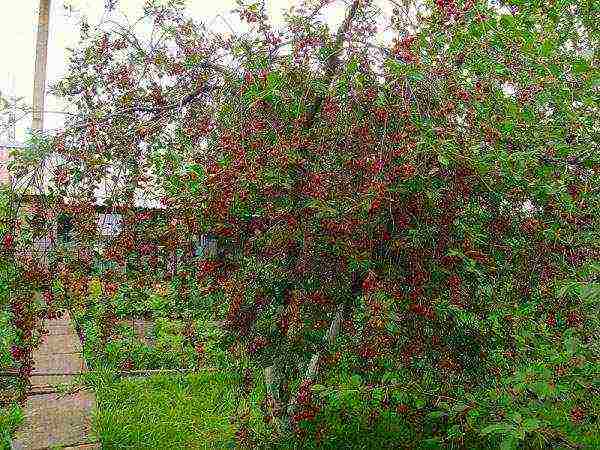 One of the advantages of this variety is its small height upon reaching adulthood - cherry grows no more than 3 meters, which greatly facilitates harvesting.
One of the advantages of this variety is its small height upon reaching adulthood - cherry grows no more than 3 meters, which greatly facilitates harvesting.
It is also important that the Lyubskaya cherry forms a crown of moderate density, albeit a spreading one. This makes it easier to follow it while trimming. The side branches are arc-shaped and are located at an acute angle to the main trunk. Cherry bark color is brown with a gray tint, the surface of the bark itself is covered with cracks.
The berries are of a beautiful deep red color; sourness prevails in the taste. For this reason, cherries of this variety are most often used when rolling compote or jam, where the acidic note can be smoothed out by adding sugar.
 The Lyubsky variety belongs to self-fertile cherry varieties for the Moscow region, and bears fruit even alone. It is possible to harvest from the second year of the tree's life, upon reaching the age of 9, the cherry comes into full force and bears fruit abundantly, while the fruits are resistant to transportation. However, after 20 years, its life cycle comes to an end and the tree is depleted.
The Lyubsky variety belongs to self-fertile cherry varieties for the Moscow region, and bears fruit even alone. It is possible to harvest from the second year of the tree's life, upon reaching the age of 9, the cherry comes into full force and bears fruit abundantly, while the fruits are resistant to transportation. However, after 20 years, its life cycle comes to an end and the tree is depleted.
The disadvantages of the Lyubskaya cherry variety include the peculiarities of the bark. Through the cracks in it, during severe frosts, the cherry can get burned, so the trunk, as well as the roots, need additional shelter.
When growing Lyubskoy cherry on acidic soils, before planting a seedling, it is necessary to lime the ground, since this variety grows poorly with high acidity.
Also, cherries of the Lyubskaya variety do not react well to frequent chemical dressings, but they will accept organic matter with gratitude. The variety is unpretentious in care, does not need pruning (except for the removal of dry shoots) and abundant watering (watering should be done sparingly, so that there is no stagnation of water near the root system).
Cherry variety Apukhtinskaya
 The variety also does not differ in its high height (2.5-3 m), it resembles a bush in shape. Abundantly bears fruit in the second year with large dark red cherries, a bit like a heart. The fruits are slightly bitter.
The variety also does not differ in its high height (2.5-3 m), it resembles a bush in shape. Abundantly bears fruit in the second year with large dark red cherries, a bit like a heart. The fruits are slightly bitter.
Apukhtinskaya cherry belongs to late self-fertile varieties, blooms in June, the harvest is harvested at the end of summer. Due to its late flowering, cherry is quite winter hardy, but at the same time, because of this, it is not suitable for use in cross-pollination. In addition, in the event of an early onset of autumn and a sharp cold snap, the cherries may not have time to ripen and will fall off. But the variety is almost immune to coccomycosis.
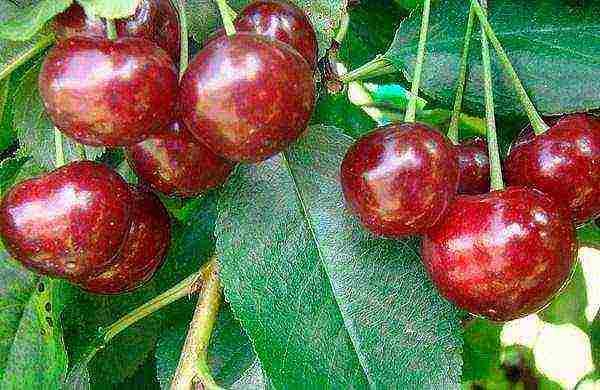 When planting Apukhtinskaya cherry for the Moscow region, you need to choose a two-year-old seedling. The most suitable place for the tree will be the south side of the garden, where the seedling will get enough sunlight necessary for normal development.
When planting Apukhtinskaya cherry for the Moscow region, you need to choose a two-year-old seedling. The most suitable place for the tree will be the south side of the garden, where the seedling will get enough sunlight necessary for normal development.
It is better to plant cherries in the fall, while choosing a place away from groundwater (no closer than 2.5 m to the surface of the earth).
This variety can be attributed to the best cherries for the Moscow region, since it is absolutely unpretentious in care. It is enough to fertilize and prune the tree in time. The first feeding is applied at planting (superphosphates, potash and organic fertilizers), the subsequent feeding is carried out once every three years. When pruning on a tree, only 5 shoots should be left per crown. The first pruning is carried out immediately after planting. Then every autumn the crown is simply cut open to maintain its shape and obtain a bountiful harvest.
As for watering, it is mandatory only when planting a seedling and during a drought. In the future, cherries do well with natural precipitation.
Cherry variety Turgenevskaya
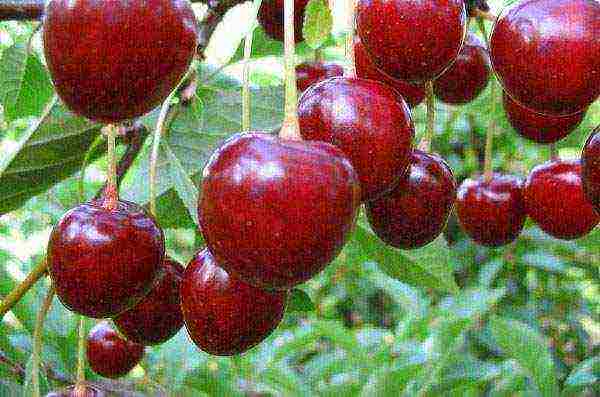 Cherry Turgenevskaya is bred on the basis of the Zhukovskaya cherry variety. The tree is also short, no more than three meters, the crown is in the form of an inverted pyramid. Fruit ripening begins at the beginning of July, with a sunny summer with sufficient precipitation, there is practically no acidity in juicy cherries.
Cherry Turgenevskaya is bred on the basis of the Zhukovskaya cherry variety. The tree is also short, no more than three meters, the crown is in the form of an inverted pyramid. Fruit ripening begins at the beginning of July, with a sunny summer with sufficient precipitation, there is practically no acidity in juicy cherries.
Unlike the previous two varieties, Turgenevka has low self-fertility, therefore it needs pollinating varieties. The best neighbor in this case will be Lyubskaya cherry.
In general, Turgenevka is the best cherry variety for the Moscow region. It winters well at low temperatures, has a resistant disease resistance. Also, the variety is characterized by a high yield, large fruits are well transported.
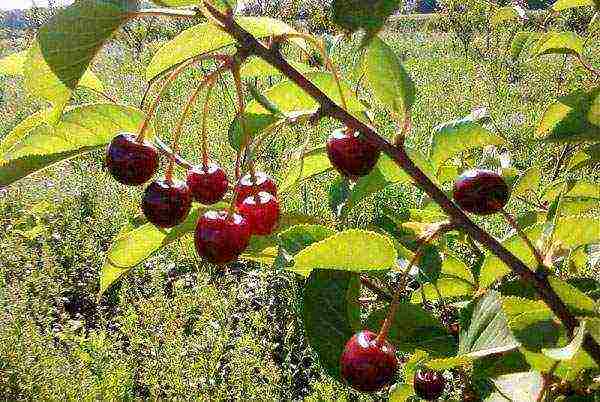 When caring for this cherry variety, you need to pay attention to the following points:
When caring for this cherry variety, you need to pay attention to the following points:
- Avoid low-lying areas when planting.
- Prune the tree annually, paying attention to the lower branches, to thin the crown.
- During the ripening period of berries, carry out additional watering.
- To protect the tree from pests, it is better to cover it for the winter.
When choosing cherries of the Turgenevka variety for cultivation in the Moscow region, it is worth considering the fact that cherries begin to bear fruit only 5 years after planting, and flower buds are afraid of spring frosts.
Cherry variety Molodezhnaya
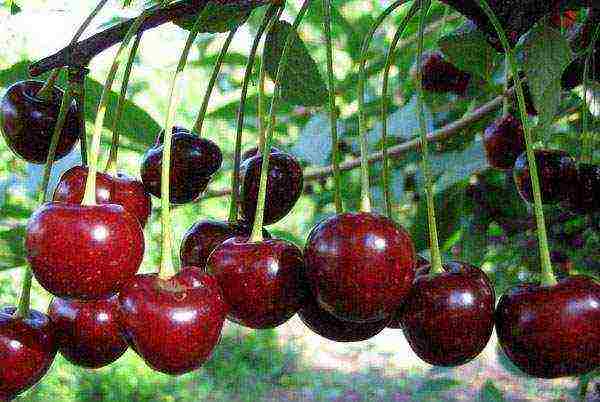 Youth cherry is a hybrid bred by crossing two varieties - Lyubsky and Vladimirsky. Cherries of this variety can grow in the form of a tree or a bush. The tree grows to a maximum of 2.5 m and is harvested at the end of July.
Youth cherry is a hybrid bred by crossing two varieties - Lyubsky and Vladimirsky. Cherries of this variety can grow in the form of a tree or a bush. The tree grows to a maximum of 2.5 m and is harvested at the end of July.
The fruits are deep red in color, have a juicy pulp and sweet and sour taste. Most often, Molodezhny cherries are consumed fresh, and they are also good in conservation.
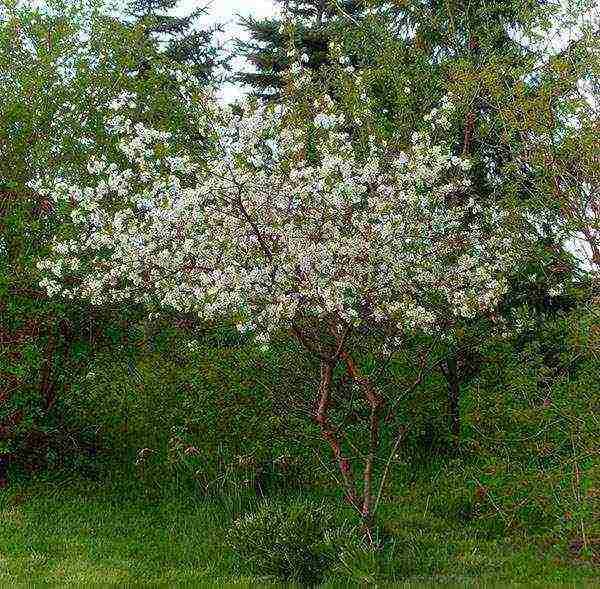 Cherry bears fruit annually and abundantly, tolerates winter frosts well. But, just like in Turgenevka, flower buds are not resistant to frost in the spring. In addition, with a rather humid summer, which is accompanied by high temperatures, they are often affected by fungal diseases.
Cherry bears fruit annually and abundantly, tolerates winter frosts well. But, just like in Turgenevka, flower buds are not resistant to frost in the spring. In addition, with a rather humid summer, which is accompanied by high temperatures, they are often affected by fungal diseases.
To grow cherries of this variety, you need to choose a well-lit place, it is better if it is on a hill. Young cherries like sandy, neutral soil and moderate watering, and also need pruning to form a crown and remove dry branches. Young seedlings need additional shelter for the winter.
The listed varieties of cherries perfectly survive in the climatic conditions of the Moscow region. They will bear fruit abundantly with proper care and the creation of the necessary conditions for their development.
Video review of the best cherry varieties for the middle lane and the Moscow region
All varieties of cherries differ among themselves in various ways, whether it is the ripening time, the size of the fruit or the region of growth. The most frost-resistant cherries are those grown in the northern regions. (Ob, Ashinskaya, Blizzard), but the most productive and sweetest varieties grow in the south of the country (Lyubskaya, Shpanka, Garland). Cherries, early ripening the most stable, but their taste is much more sour (Shokoladnitsa, Molodezhnaya), medium ripening varieties are the golden mean (Vladimirskaya, Zhukovskaya, Turgenevka). Another sign is the presence of flowers of both sexes, that is, self-fertility (Apkhutinskaya, Pamyat Yenikiev). To choose the most suitable cherry variety, you need to know all their characteristics.
Self-fertile varieties of cherries
Self-fertile varieties include cherries that no additional pollination required, and they independently set both male and female flowers.
Apukhtinskaya
A medium-sized tree on which large and tasty heart-shaped fruits grow. The Apukhtinskaya variety begins to bear fruit already in the second year after planting, refers to late ripening, the ripening of the crop falls in mid-August. The tree has good resistance to frost and drought, but it is also susceptible to fungal diseases.
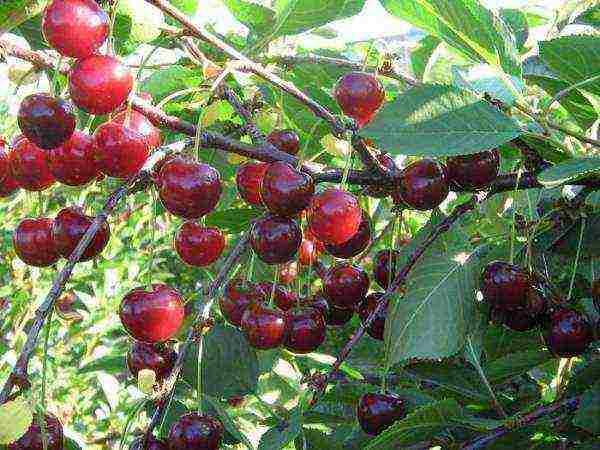 Cherry variety Apukhtinskaya
Cherry variety Apukhtinskaya
Memory of Yenikiev
The tree grows up to 3 meters in height, the crown is of medium density, spherical in shape. Fruit weight reaches 5 gramsso they can be considered large. The shape of the berries is oval, the color is dark red. Cherry pulp Yenikiev's memory is very tasty and juicy. The variety is distinguished by the presence of a large bone... The tree begins to bear fruit already at 3-4 years of age, the period of full ripening of the crop falls at the end of June. Up to 15 kilograms of fruit can be harvested from one cherry.... It has medium resistance to frost and drought.
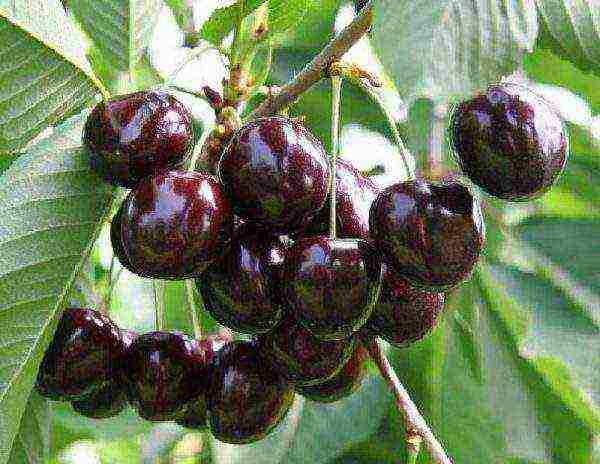 Cherry in Memory of Yenikeev
Cherry in Memory of Yenikeev
Also, self-fertile varieties of cherries include Garland, Brunette, Cinderella, Shokoladnitsa, ErdiBetermo, Ksenia, Nochka, Vstrecha, etc.
Early varieties of cherries
Cherry varieties that ripen between early June and mid-July are called early cherry varieties.... Their berries are less sweet, and the trees have good frost resistance.
Chocolate girl
This cherry tree is of medium height, with a crown shape reminiscent of an inverted cone. The berries are distinguished by their sour taste and maroon color. The pulp is a deep red shade, dense, with an easily detachable bone... The Shokoladnitsa variety tolerates frost and drought well, is resistant to many diseases, and is self-fertile. Brings a stable harvest.
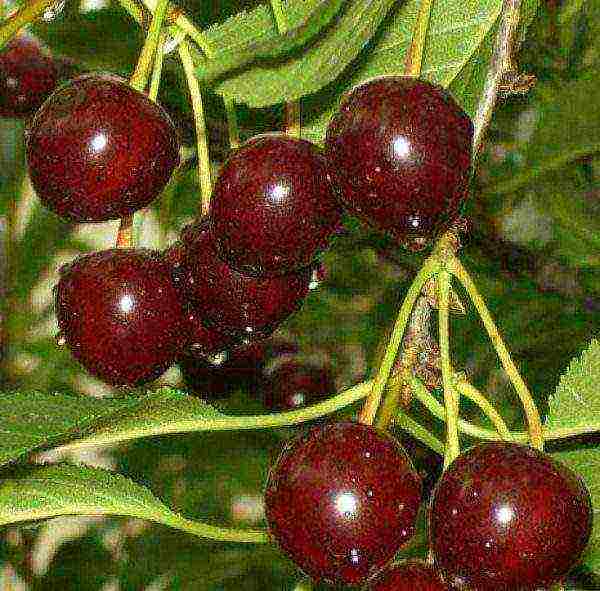 Cherry Shokoladnitsa
Cherry Shokoladnitsa
Spunk
This variety is a cherry-cherry hybrid. A tall tree with freely growing branches resembles a ball in its shape. In addition, the attachment of branches to the tree is rather weak, so when the crop appears, there is a risk that they will begin to break. The taste of berries is sweet and sour, on average, their weight is 4 grams... Fruit color is dark red, rounded-flattened shape. The first crop of Spanka brings in 6-7 years of life, but at the age of 20 you can get up to 60 kilograms of cherries from a tree. Fruiting occurs from late June to early July... The variety is highly resistant to frost and drought and needs pollinators.
 Cherry varieties Shpanka
Cherry varieties Shpanka
Youth
Shrub cherry, with a low, slightly drooping crown. The fruits of the Molodezhnaya variety are large in size, their weight can reach 4.8 grams, the skin and pulp have the same maroon color. The stone separates well, and a slight sourness is felt in the taste of the cherries themselves, such berries are perfect for preservation and freezing. The first crop appears on a 5-year-old tree, fruiting mainly occurs on last year's wood... Molodezhnaya is a frost-resistant variety. Has an average disease resistance.
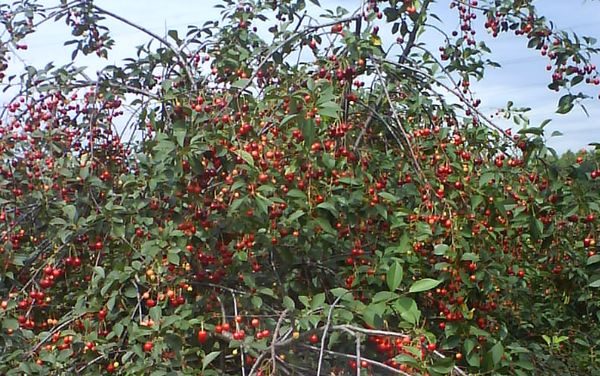 Shrub self-fertile cherry variety Molodezhnaya
Shrub self-fertile cherry variety Molodezhnaya
Miracle cherry
Arboreal cherry with medium vigor. The crown of the tree needs constant formation, with a free form of growth, it looks like a cone, and the fruits will accumulate at the very top. The taste of berries is dessert, sweet, in all their external characteristics they resemble cherries, can reach a weight of 9.5 grams. The variety is self-fertile and needs pollinators. The tree begins to bear fruit from the age of 3 years, while bringing a large, stable harvest. You can harvest the fruits already at the beginning of June. Miracle cherry is resistant to frost and most diseases.
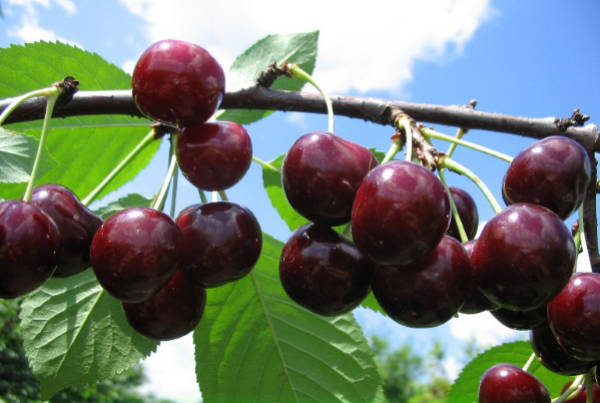 Variety Miracle cherry
Variety Miracle cherry
Baby
The tree is of medium height and spherical in shape. It bears beautiful dark red fruits with a pleasant sweet and sour taste, the stone is easily separated from the pulp. The shape of the berries is round, evenly flattened, the weight reaches 5 grams... Variety Malyshka Differs in good transportability, immunity to fungal diseases and frost resistance. Productivity is inferior to other varieties, from one tree you can get 17 kilograms of cherries. Their full maturity falls at the end of June.
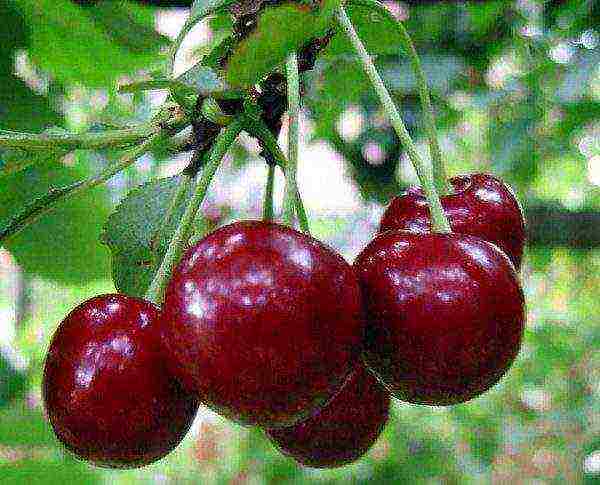 Cherry variety Baby
Cherry variety Baby
There are also other early ripening varieties of cherries. For example, Memory, Bulatnikovskaya, Enikeeva, Bagryanka, Sania, Vasilievskaya.
Medium ripening cherry varieties
Middle-early cherries are called cherries that ripen in the middle of summer, they have the best taste.
Vladimirskaya
 Cherry fruits Vladimirskaya
Cherry fruits Vladimirskaya
Vladimirskaya - one of the oldest varieties grown in the central regions of Russia. Bushy tree, grayish bark... The branches grow downward, so the shape of the crown is called weeping. 5-7 flowers of delicate white color are collected on one inflorescence.Leaves of a matte green shade, elongated, gradually sharpening towards the base and apex, the edge is double-serrate. Fruits are sweet and sour, slightly fibrous, well suited for any form of processing. The color of the skin is dark red, almost black, the weight of the berries does not exceed 3.7 grams, the shape is round-flattened. The first fruiting occurs in the 3rd year of life, cherry ripening occurs at the end of July. This variety tolerates winter cold well, but spring frosts can completely destroy the inflorescences, and, accordingly, the entire crop. It grows best in central Russia, with good care it can bear 25 kilograms of fruit. In the northern regions, the yield drops sharply to 6-7 kilograms.... Vladimirskaya needs pollinators and additional protection from diseases and pests. If the berries are not picked in time, they will begin to crumble very quickly.
Zhukovskaya
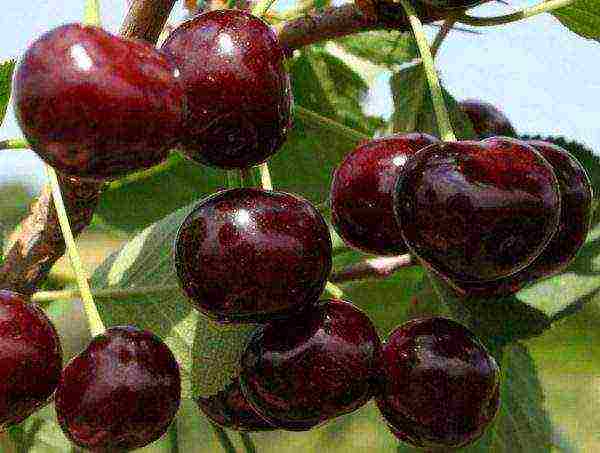 Cherry variety Zhukovskaya
Cherry variety Zhukovskaya
Cherry grows up to 2.5 meters, the crown of the tree is spreading, but rare. Leaves are narrow, oval, dark green in color. Forms inflorescences of 3-4 flowers, medium-sized with rounded petals. Fruiting occurs on last year's annual wood... Most often, the berries are located singly, sometimes in two. Cherry varieties Zhukovskaya medium size, up to 4 grams, dark red, heart-shaped. The pulp is tender, juicy, with a dessert taste. Disease resistance is average.
Kharitonovskaya
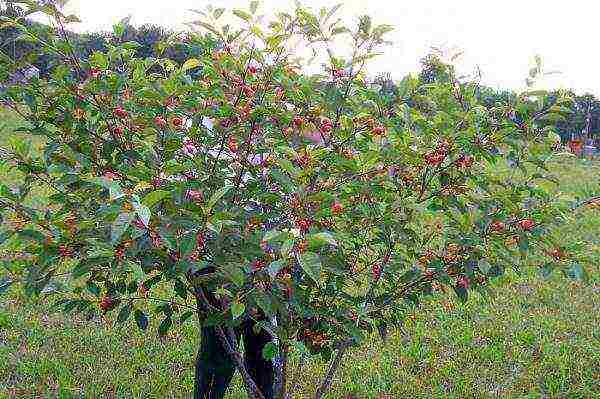 Cherry variety Kharitonovskaya
Cherry variety Kharitonovskaya
The tree grows to medium size, the flowers are large, white. The berries themselves are evenly rounded, the skin is bright red, the flesh is orange. They have a sweet and sour taste, the stone is easily separated... Good immunity to various diseases, normal frost resistance. The Kharitonovskaya variety needs additional pollination.
Turgenevka
 Cherry varieties Turgenevka
Cherry varieties Turgenevka
A cherry tree of this variety grows up to 3 meters, forms inflorescences of 4 white flowers. Fruiting occurs on bouquet twigs. Berries are broadly heart-shaped, large in size, weighing up to 6.5 grams... The skin color is dark red, the pulp is juicy, sour-sweet, the taste is normal. The first harvest ripens at 5-6 years of age, full ripening of fruits occurs in early July. Turgenevka tolerates winter frosts well, but may die when spring frosts appear... Possesses high resistance to diseases, requires pollinators. The variety produces a good, stable yield.
Morozovka
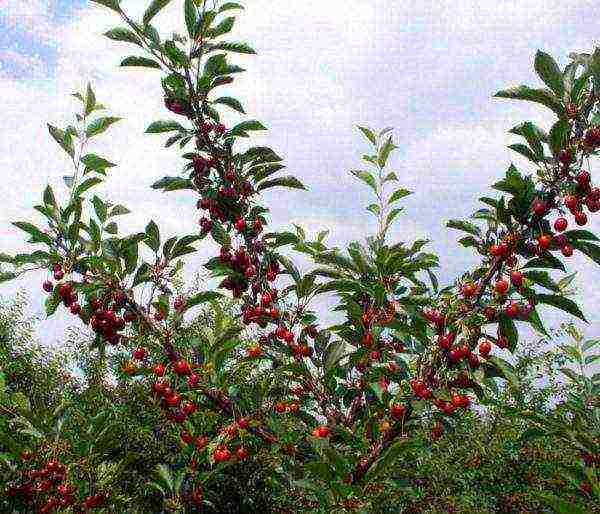 Cherry with fruits grade Morozovka
Cherry with fruits grade Morozovka
The tree grows medium in size, the crown is wide, spreading. Fruiting occurs on bouquet twigs, the berries are round in shape with a fossa at the stalk, the weight can reach 5.5 grams. The skin is dark burgundy, the pulp is juicy, dessert taste with an easily detachable bone... Such berries are suitable both for fresh consumption and for processing, they are well transported. The tree begins to bear fruit at the age of 3 years; the fruit of the Morozovka variety ripens at the end of July. The yield is stable, up to 500 kilograms per hundred square meters... The variety is resistant to frost, drought and disease. Needs pollinators.
Also, the average ripening period is possessed by the varieties Radonezh, Vstrecha, Toy, Nochka.
Late varieties of cherries
Late varieties are the last to ripen, in late summer and early autumn..
Lyubskaya
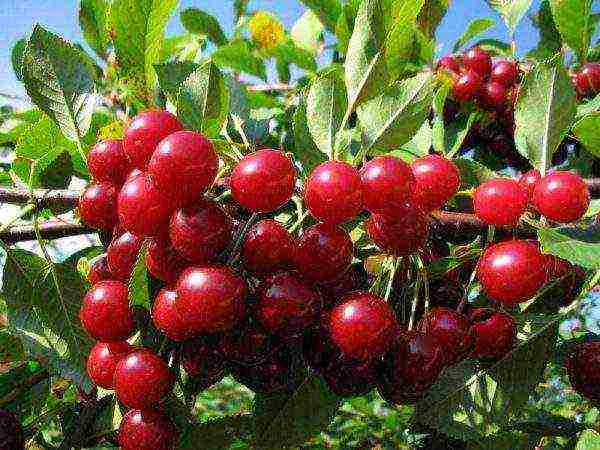 Harvest of cherries of the variety Lyubskaya
Harvest of cherries of the variety Lyubskaya
The variety is intended for cultivation in central and southern Russia, it is very demanding on soil fertility and quality of care. Produces a large crop with blood-red, transportable fruits with a mediocre taste... These berries are ideal for processing. The tree is self-fertile, but with additional pollination it gives higher yields. A young tree bears up to 26 kilograms of fruit, and an adult up to 60. Lyubskaya does not have frost resistance, it is often exposed to various diseases.
Generous
 Cherry variety Generous
Cherry variety Generous
Bushy cherry with upturned shoots.The weight of one cherry is about 4 grams, its shape is round, the color is bright red. Pulp with good taste, the stone is easily separated. The presentation of the berries is at the highest level, they are resistant to cracking. Variety Generous gives an annual, bountiful harvest, ripens in autumn... The tree gives its first cherries as early as 3-4 years. Generous is distinguished by high frost resistance, can easily tolerate even spring frosts, and the variety does not lend itself to attacks by pests, and tolerates drought well. Susceptible to diseases, especially fungal diseases.
Robin
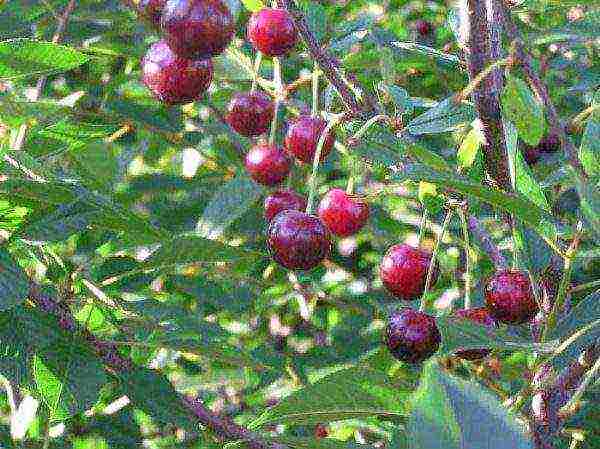 Cherry variety Malinovka
Cherry variety Malinovka
A tree of medium height with a spherical crown. Leaves with a wide plate, glossy, green, crenate edge. The cherries are small, on average, the weight of one berry is 3-3.5 grams, the shape is round... The taste is sweet and sour, pleasant, the pulp is dense. The variety gives an annual, bountiful harvest that ripens in early August. The robin needs additional pollinators and protection from disease. Frost resistance - medium.
Other varieties of late-ripening cherries are Zhuravka, Polevka, Rubinovaya, Lotovaya, Rusinka, Gorkovskaya.
Large varieties of cherries
Cherry varieties with large dessert berries are not inferior to sweet cherries in their taste. But compared to other varieties, they are whimsical to climatic conditions and quality of care.
Consumer goods Black
 Cherry variety Consumer goods Black
Cherry variety Consumer goods Black
A low-growing tree with very tasty berries with a dark skin of almost black color. The pulp is juicy, tender, with an easily detachable bone. The fruits ripen Consumer goods Black in early June, the yield of the variety is moderate... Has a weak resistance to frost. The tree needs additional pollination.
Volochaevka
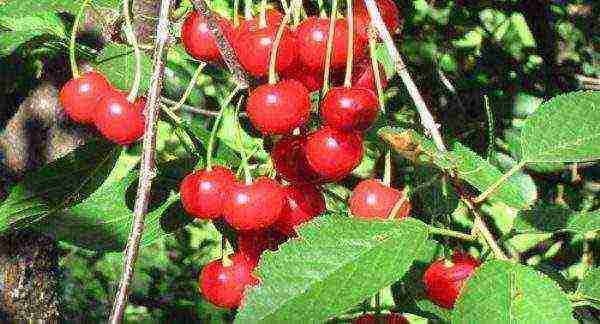 Cherry Volochaevka
Cherry Volochaevka
A medium-sized tree is capable of producing an annual harvest. The berries are sweet, juicy with firm pulp and easily removable pits. Ripens in mid-July. The variety does not tolerate frost well, in the rainy season there is a risk of rot... Volochaevka forms both female and male flowers, self-fertile.
A meeting
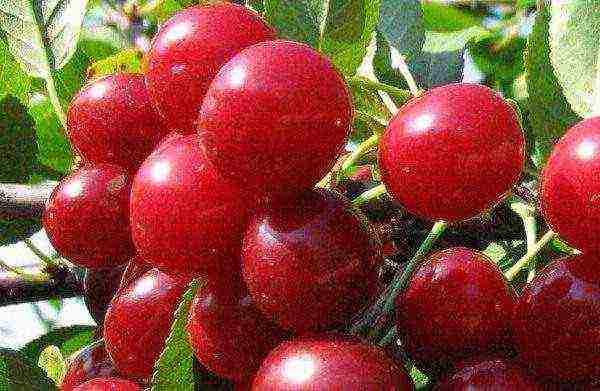 Cherry variety Meeting
Cherry variety Meeting
A low tree, the weight of the fruit of which exceeds the mark of 10 grams. The berries are bright red, with a tender and juicy pulp... The harvest of the Vetska variety is stable and annual, ripening falls on the 20th of June. The variety tolerates frost and drought well, and is resistant to fungal diseases.
Also, varieties with large fruits include Molodezhnaya, Dessertnaya Morozova, Pamyat Yenikeev, Podbelskaya, Minx, Toy, etc.
Low-growing (dwarf) cherry varieties
Trees of such varieties grow no higher than 2.5 meters.... They are very convenient for breeding and harvesting, therefore they are very popular among gardeners.
Anthracite
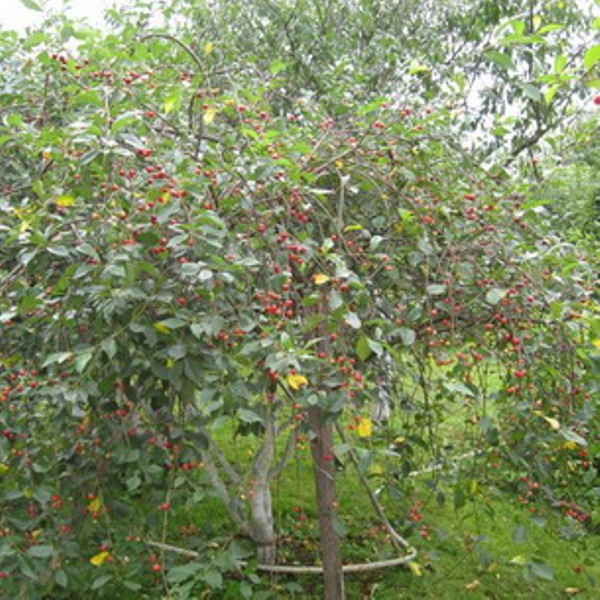 Common cherry Anthracite
Common cherry Anthracite
A bushy cherry with a wide crown, its maximum growth is 2 meters. The skin of the berries is dark, almost black in color, the pulp is blood red.... Fruit weight is 4-5 grams, taste is good. Cherries ripen in mid-summer and are well transported. The Anthracite variety is resistant to frost, drought and fungus.
Bystrinka
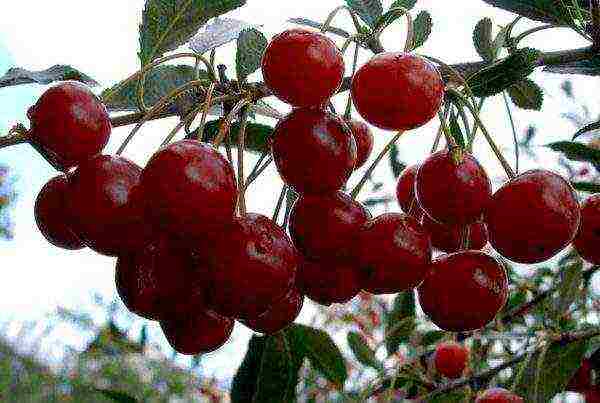 Low-growing cherry variety Bystrinka
Low-growing cherry variety Bystrinka
The small tree forms a spherical crown. Burgundy berries, with the same color pulp, their weight ranges from 3.5-4.2 grams, well transported. The taste is sweet and sour. The harvest period is early July... The resistance of the Bystrinka variety to frost is average. There is a risk of damage from moniliosis.
Mtsenskaya
 Cherry grade Mtsenskaya
Cherry grade Mtsenskaya
The tree rarely exceeds 2 meters in height, the crown is oval. Average, one berry weighs 4 grams, skin color is maroon... Most often, the fruits of the Mtsenskaya variety are processed. The trees are characterized by good resistance to frost, drought and most diseases. They also have an attractive appearance, which is why they are often used in landscape design.
There are many undersized varieties of cherries, these include Lyubskaya, Molodezhnaya, Memory Mashkin, Shokoladnitsa, Vladimirskaya, Tamaris and Saratov baby.
The best cherry varieties for the southern regions of Russia
Such varieties are distinguished by excellent taste, low or medium frost resistance. Their cultivation is possible only in warm climatic conditions.
Sasha
On average, the tree grows up to 3-4 meters, the foliage is average. Fruiting occurs on annual shoots. The fruits are large, juicy, red. They are distinguished by excellent taste. The Sasha variety is frost-resistant, rarely exposed to diseases.... The first fruiting occurs in the 5th year of life, early ripening.
Garland
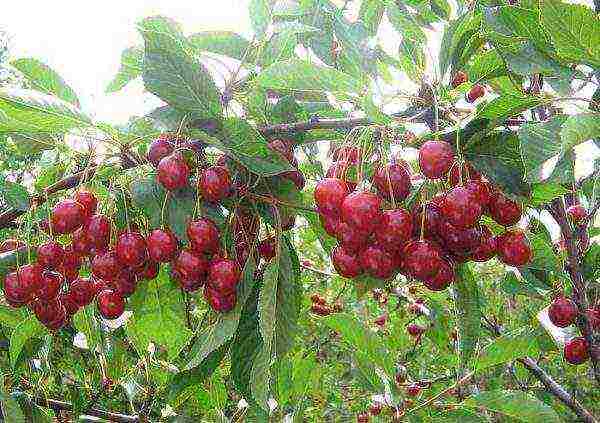 Cherry variety Garland
Cherry variety Garland
The growth of the tree is 3 meters, a large amount of foliage is formed on the branches. The Garland variety is distinguished by the presence of inflorescences, of which 5 fruits appear. The berries are very large, juicy and tasty, the skin color is slightly darker than the flesh. The first crop can be harvested in mid-June as early as the 3rd year of life... The tree does not need additional pollination.
Also, for the southern regions, varieties such as Lyubskaya, Shpanka, Shokoladnitsa are suitable.
The best cherry varieties for the northern regions
Ashinskaya
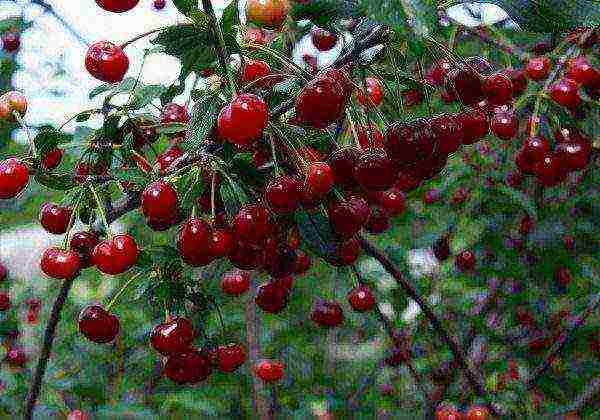 Cherry grade Ashinskaya
Cherry grade Ashinskaya
It is considered the best variety for the northern regions. A low-growing shrub, whose growth does not exceed 1.5 meters, can tolerate frosts down to -55 degrees... Also drought tolerant. Berries are dark in color, with dense pulp, slightly astringent, sweet and sour taste. The bone is small, easy to remove. Flowering occurs from the beginning of April, the shrub gives its first harvest at 4 years of age.
Ob
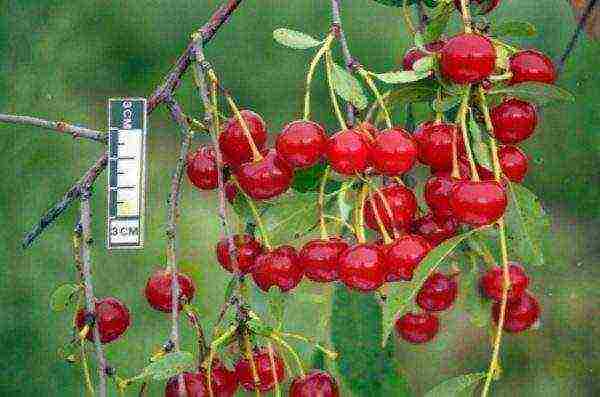 Cherry Ob
Cherry Ob
A short shrub that is only 130 centimeters tall. Fruiting occurs on annual growths. Berries are small, dark red in color, with a good taste and a small, well-separated seed... Fruits ripen in mid-July. The Ob is capable of withstanding severe frosts and drought, but is highly susceptible to pest attacks. The variety is self-fertile and does not need pollination.
Altai swallow
 Cherry variety Altai swallow
Cherry variety Altai swallow
A low-growing bush, no more than 150 centimeters high. The berries are round in shape and medium in size, distinguished by excellent taste and juiciness... Fruit ripening occurs in mid-July. The yield of the variety is very different from the trees growing in the southern regions, and is only 5 kilograms. The Altai swallow tolerates frost and drought well, and is immune to many diseases. It is also a pollinator for many cherry varieties.
For the northern regions, the Novoaltaiskaya and Metelitsa varieties may be suitable.
The most delicious cherry varieties for Siberia and the Urals
Such varieties of cherries adapt well to the changeable climate of Siberia and the Urals, besides, they are distinguished by good yield and taste.
Ural ruby
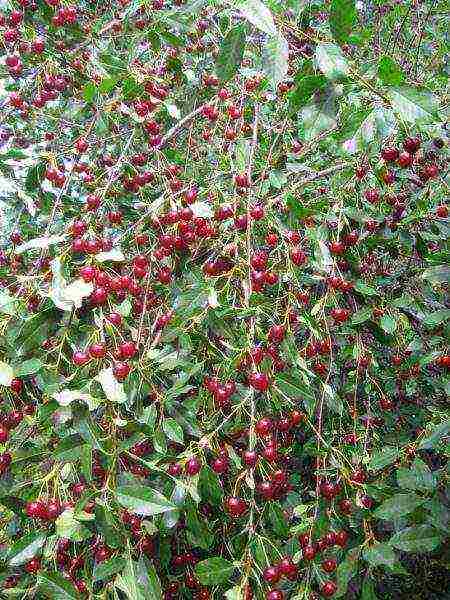 Cherry shrub Ural ruby
Cherry shrub Ural ruby
A shrub, whose growth is 1.5 meters, the crown is wide, the branches are weeping, growing downward. The leaves are wide, shiny, dark green in color, their shape resembles a boat. Fruits weigh only 3-4 grams, round in shape, dark red, juicy, sweet and sour taste... Ripen in mid-August. The variety is self-fertile, but it has a stable and good yield; an adult tree bears up to 10 kilograms of berries.
Lighthouse
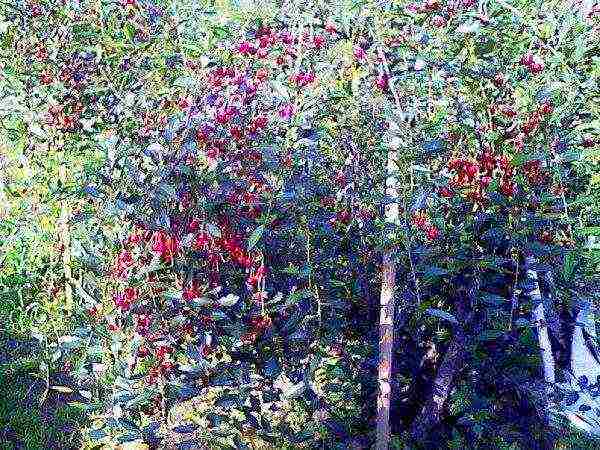 Siberian cherry variety Mayak
Siberian cherry variety Mayak
Lighthouse - a bush 2 meters high with a wide spreading crown and leaves folded into a boat. The Siberian variety is self-fertile, but when planted next to such varieties as Vole and Schedra, it gives the most abundant yields. Fruits gain weight up to 6 grams, dark red, sour-sweet taste. The crop can be harvested in early August, on average, one bush gives from 5 to 15 kilograms of fruit.
Also for these territories, the varieties Standard Ural, Schedra, Sverdlovchanka, Zagrebinskaya and Gridnevskaya are suitable.
The best cherry varieties for the Moscow region, description and care
The varieties that are best suited for the Moscow region must have good resistance to frost, and be unpretentious to the composition of the soil, a description of which can be found below.
Early varieties
From the category of early varieties of the Moscow region the varieties Molodezhnaya and Chudo cherry are best suited.
Among the mid-season varieties, one can distinguish Turgenevka, Excellent Venyaminova and Griot Moskovsky.
Griot of Moscow
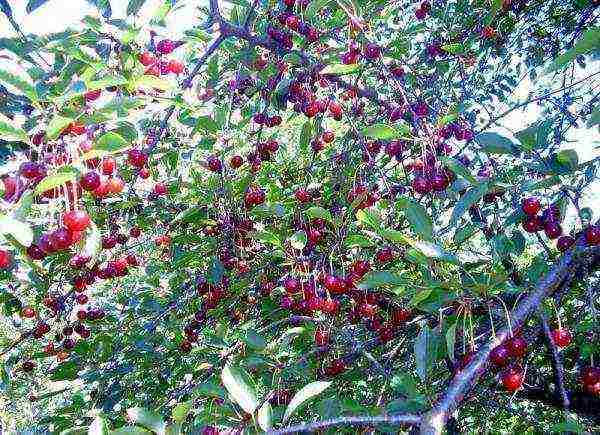 Cherry for Moscow region Griot Moskovsky
Cherry for Moscow region Griot Moskovsky
A tree with a spherical crown and matte leaves. Berries reach 3.5 grams in their weight, taste characteristics are at the highest level, fruits are suitable for various types of processing... Such a variety ripens in mid-July, the yield is above average, from a hundred square meters you can get up to a ton of cherries. Resistance to winter cold and return frost is excellent. Undergoes coccomycosis and monial burn.
Late varieties
Among the varieties of late ripening Zhukovskaya has recommended herself in the best way.
The undersized (dwarf) cherry varieties for the Moscow region include Molodezhnaya, Mayak, Tamaris, Bystrinka, Memory Mashkin and Malyshka.
Tamaris
The crown of the tree is small, rounded. Fruits are dark red in color with sparse brown spots. The pulp of the berries is juicy, the taste is sour. Cherries can be used both for fresh consumption and for various processing, the transportability of the fruits is average. You can harvest the crop in early August. The variety has good frost and drought resistance.
In memory of Mashkin
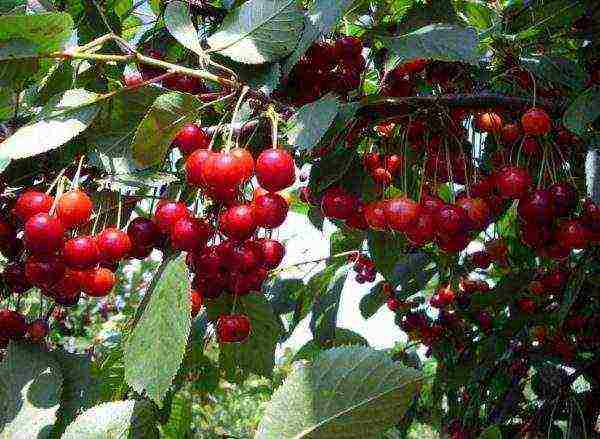 Cherry variety in Memory of Mashkin
Cherry variety in Memory of Mashkin
The crown of the tree is spreading, drooping, spherical in shape. The fruits are large in size, grow up to 5 grams, with their own dessert taste, they often become an adornment of any garden. Maturation occurs in mid-July... Resistance to frost and sore immunity is average.
Self-fertile varieties
The most popular self-fertile varieties for the Moscow region are Apukhtinskaya, Lyubskaya, Zagorievskaya, Volochaevka, Shokoladnitsa, Vstrecha, Garland and Cinderella.
Cinderella
Medium-sized tree, forming fruits weighing 4 grams, rounded oval and light red in color, sweet and sour taste. The harvest ripens in mid-July, from one tree you can get up to 15 kilograms of berries... The frost resistance of the tree itself and of the flower buds is excellent. The variety does not require additional protection against fungal diseases.
Breeders have bred a huge number of cherry varieties, which makes it possible to grow this crop in all corners of Russia. For the most part, all trees have good to medium frost resistance and bear sweet and sour fruits.... Each gardener can choose and plant the cherry that will decorate his particular plot.
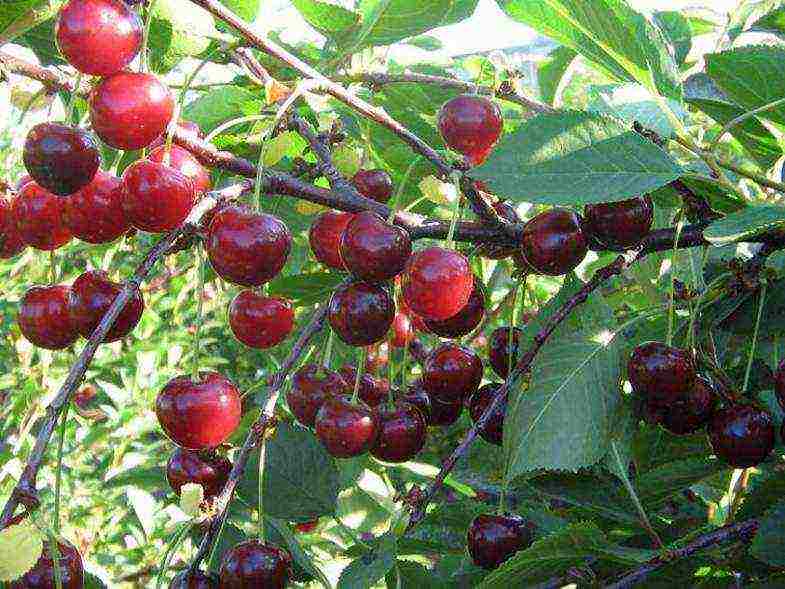
Gardens near Moscow have always been famous for their cherry harvest. Now many gardeners consider it a capricious and difficult crop to grow. Let's try to figure out if this is so. Let's see what you need to look for when choosing cherry varieties for the Moscow region.
How to choose a cherry for the Moscow region
Winter hardiness
Given the cold, and often just frosty winters, cherry varieties for the Moscow region should easily endure winter frosts and thaws, i.e. have good winter hardiness. It is desirable that both the tree itself and its flower buds be winter-hardy.
Winter-hardy cherry varieties for the Moscow region:
- Bulatnikovskaya,
- Volochaevka,
- Lyubskaya,
- Robin,
- Youth,
- Chocolate girl,
- Turgenevka,
- Fairy.
Disease resistance
Such dangerous diseases as coccomycosis, moniliosis, clasterosporosis, which have spread in recent years, bring great damage to cherry orchards. When choosing cherry varieties for the Moscow region, you should choose those varieties that are little susceptible to these diseases.
Most resistant to disease:
- Bulatnikovskaya,
- Morozovka,
- Radonezh,
- Silvia,
- Turgenevka,
- Fairy,
- Kharitonovskaya.
Self-fertility
During the cherry blossoms in the Moscow region, cold, rainy weather often happens when the bees do not fly and cannot pollinate the flowers. And, as a result, there is no harvest. Salvation in this case is to plant self-fertile varieties that can set fruits by pollination with their own pollen, without the help of insects.
Self-fertile cherry varieties for the Moscow region:
- Apukhtinkaya,
- Lyubskaya,
- Bulatnikovskaya,
- Volochaevka,
- Youth,
- Radonezh,
- Chocolate girl.
Yield
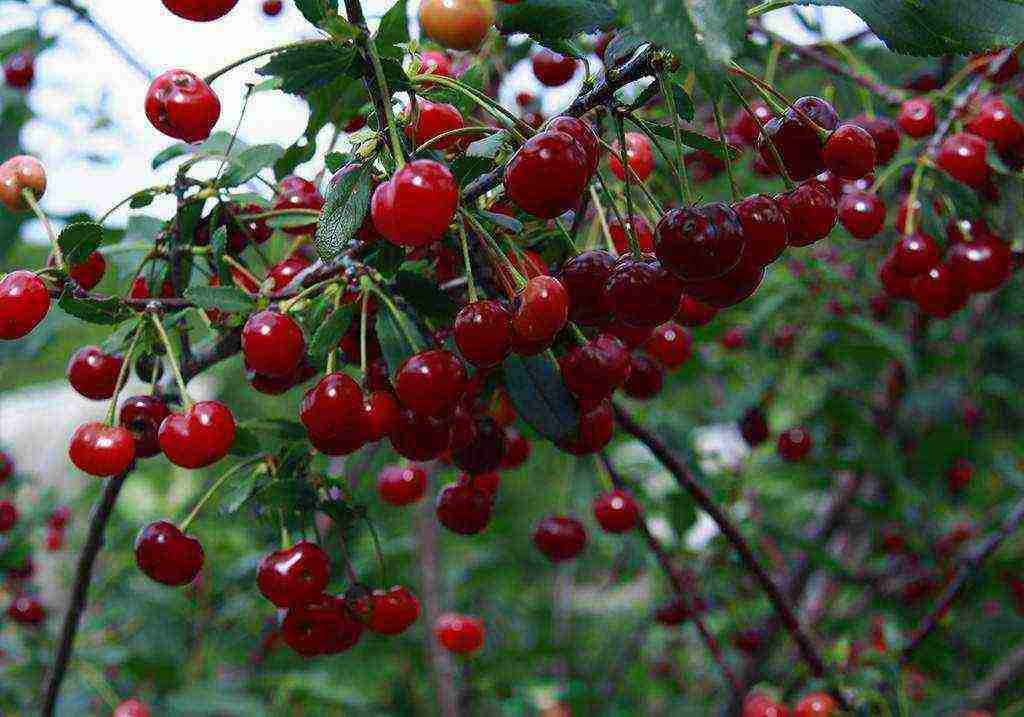
Harvest
By planting a cherry tree on our site, we expect to get good yields. They can be provided to us by:
- Apukhtinskaya,
- Volochaevka,
- Lyubskaya,
- Livenskaya,
- Robin.
Tree size
Cherry trees can be either tall or short. In a private garden, especially a small one, it is good to have short trees. They take little revenge and are easy to harvest.
Low-growing cherries for the Moscow region:
- Lyubskaya,
- Youth,
- Morozovka,
- Radonezh,
- Chocolate girl.
Ripening terms
By the timing of ripening, cherries can be divided into early, middle and late. Most of all mid-season varieties.
The best cherry varieties for the Moscow region
Apukhtinskaya
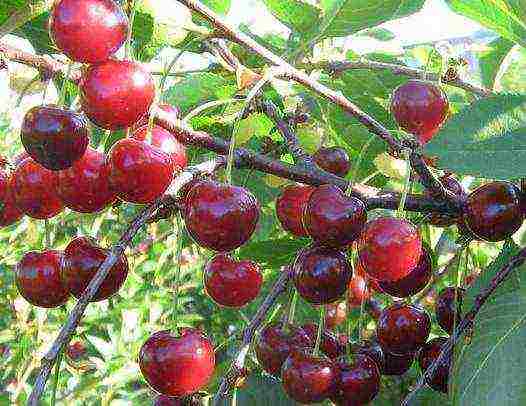
Apukhtinskaya
An old, but not losing popularity variety. Bears fruit abundantly and annually. Dark red, almost black fruits have a pleasant sour taste, ripen in July and August. They make a very good jam. The disadvantages include the average winter hardiness and susceptibility to coccomycosis disease.
Volochaevka
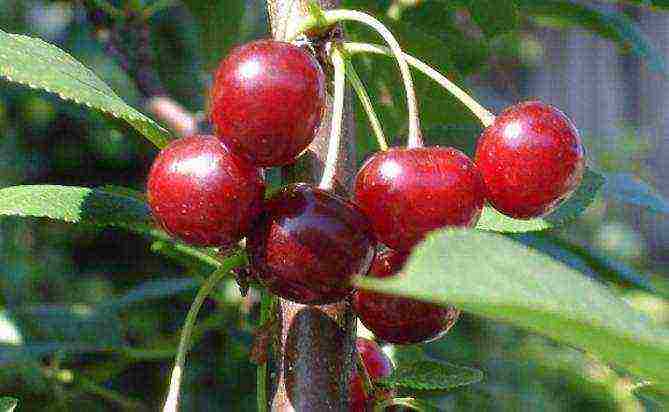
Volochaevka
One of the most reliable mid-season varieties zoned in the Central region. It regularly produces large yields of large fruits weighing about 4.5 g. They are dark ruby color, juicy, sweet and sour taste, with a delicate cherry aroma. This variety is self-fertile, it tolerates winter frosts well, the tree is of medium height. The susceptibility to diseases is average.
Robin
Dark red sweet sour fruits ripen in late July - early August. Winter hardiness is good in two respects: wood and flower buds. The tree is not very large (3–3.5 m), but every year it brings abundant harvests of berries. Disadvantages: has an average resistance to fungal diseases. The fruits are more suitable for processing.
Youth
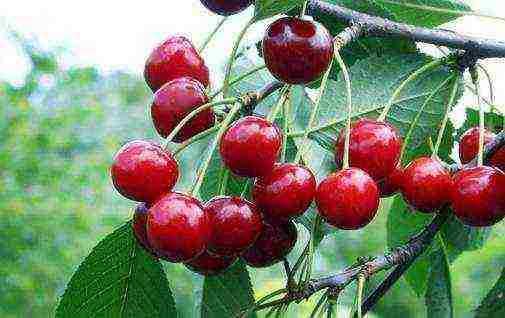
Youth
A popular medium-ripening cherry variety obtained from crossing the old Russian varieties Vladimirskaya and Lyubskaya. Early, 3-4 years, brings the first harvest. Bears fruit annually and abundantly. The berries are large and tasty. Among the advantages of Molodezhnaya, one should also note such qualities as self-fertility, short stature and winter hardiness of the tree. The disadvantages include the weak resistance of flower buds to the spring cold and only average resistance to moniliosis and coccomycosis.
Lyubskaya
An ancient variety of cherries of national selection. Ripens late, in August. It is popular due to its qualities such as self-fertility, the early onset of fruiting: it bears the first berries for 3-4 years, low tree growth, high and annual yield. Disadvantages: susceptibility to fungal diseases, sour taste of the fruit.
Radonezh
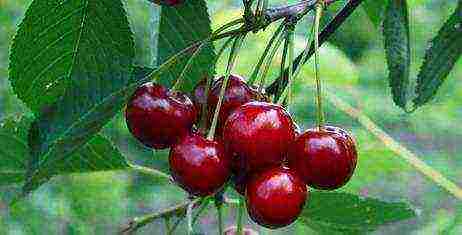
Radonezh
This variety was bred by the Bryansk breeders A.A. Astakhov and M.V. Kanshina is not as well known to gardeners as he deserves. A short tree tolerates winter low temperatures well. Since the fourth year, it yields harvests of dark red berries with a good sweet and sour taste. Fruits are medium-large in size, weighing 4-4.5 g. Radonezh is partially self-fertile and, which is very important, has good resistance to major fungal diseases. The disadvantages include the average yield.
Turgenevka
Large-fruited, winter-hardy cherry variety, widespread in gardens near Moscow. It ripens in medium terms: early-mid-July. Quite resistant to coccomycosis and moniliosis. The tree is small, up to 3 m high, is not afraid of drought, it recovers well after freezing. Good harvests every year.The berries are large, very juicy, and have a pleasant taste.
Chocolate girl
Low cherry with dark red tasty fruits. Self-fertile, with good winter hardiness of wood and buds. The tree is 2-2.5 m high, drought-resistant, begins to bear fruit in 4 years. The disadvantage is susceptibility to coccomycosis and moniliosis, average yield.
Landing
Plots
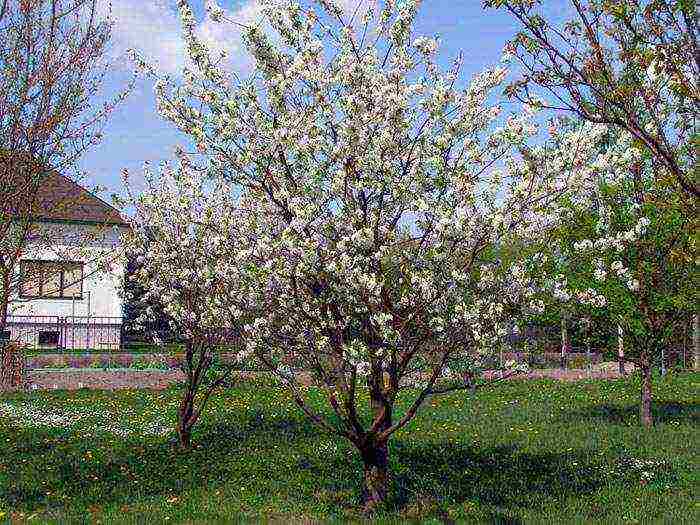
In the garden
For planting cherries, select areas that:
- are on a dais,
- well ventilated,
- illuminated by the sun,
- protected from cold air currents.
Unsuitable for growing cherries:
- lowlands, hollows;
- places with a close occurrence of groundwater (closer than 2 m).
The soil
The most suitable soil for a cherry orchard is light to medium loam with neutral acidity. On heavy clay soils, you need to add sand, carry out liming (add lime at the rate of 0.5 kg per 1 square meter).
Boarding time
In the Moscow region, the best time for planting cherries is spring. Since cherries, like all stone fruit crops, begin to wake up early, seedlings with an open root system should be planted as early as possible - as soon as the snow melts. Autumn planting is undesirable. It is better to dig in the seedlings bought in the fall obliquely and leave them to winter under the snow until spring. Plants with a closed root system, i.e. in pots, you can plant the entire warm season until frost.
The presence of pollinating combs
When planting a cherry orchard, you should take care of the presence of pollinator varieties
Since most varieties of cherries are self-fertile or partially self-fertile, then, in order to obtain good yields when planting, it is necessary to use several varieties, among which there will be universal pollinators. This is useful even for varieties that are considered self-fertile, as they produce large yields in the presence of pollinators.
Care
Cherry tree care consists of:
- watering,
- annual pruning,
- spring fertilization,
- autumn liming of the soil,
- protection from diseases and pests.
The most common fruit diseases
The damp climate of the Moscow region contributes to the spread of such dangerous fungal diseases of cherry as coccomycosis, clotterosporosis and moniliosis.
Coccomycosis
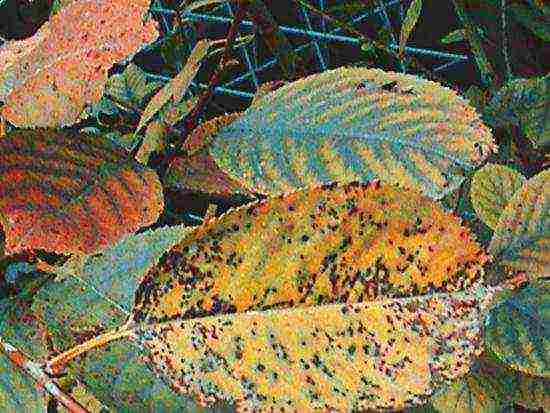
Coccomycosis
In case of coccomycosis, the leaves are covered with brown spots, and depressed brown spots appear on the fruits. Such fruits are tasteless and often dry out. With a strong development of the disease, the leaves turn yellow and fall off early, which leads to the weakening of the tree and its freezing in winter.
Clasterosporosis
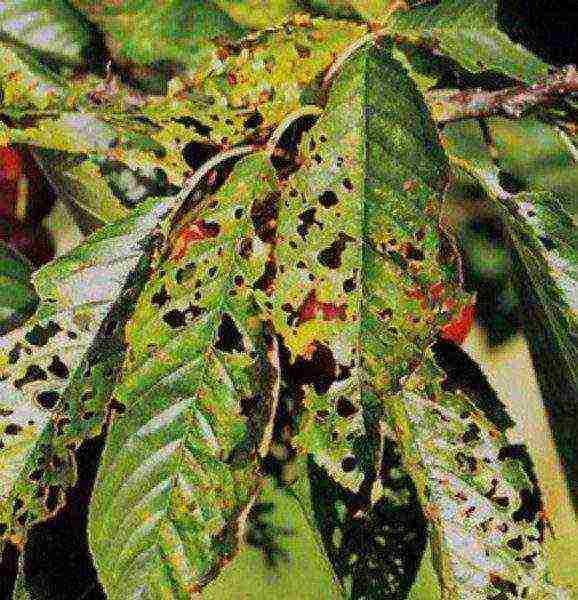
Clasterosporosis
Clasterosporosis or perforated leaf spot. It affects all parts of the plant. Small brown spots appear on the leaves, which grow and holes form in their place. Cracks appear on the branches and resin flows out of them. The fruits stop growing and dry up.
Moniliosis (or monilial burn)
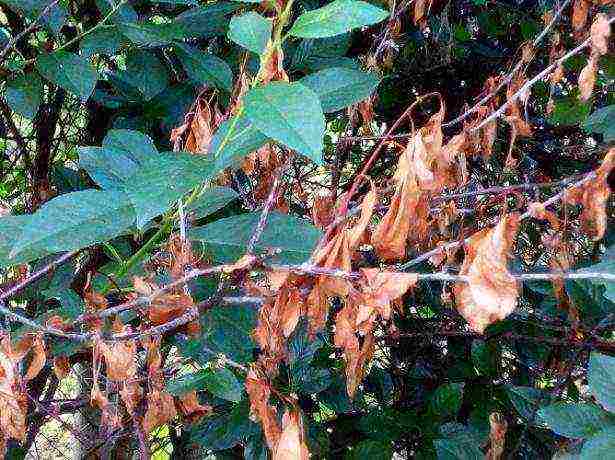
Monilial burn
The first signs of the disease appear immediately after flowering. Affected flowers darken and dry out. Further, the disease spreads to leaves and shoots. They also turn brown and dry out. The wood takes on a burnt appearance. The fruits rot. The branches affected by the disease dry out.
Observance of correct agricultural practices, mandatory spring treatment of the garden from diseases, removal of diseased and dried branches and fruits, as well as the correct choice of cherry varieties for planting will help to overcome these dangerous diseases and get good harvests annually in the gardens of the Moscow region.
